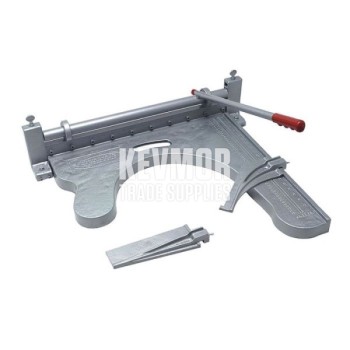



PLEASE NOTE DUE TO THE WEIGHT AND/OR SIZE OF THIS PRODUCT IS NOT ELIGIBLE FOR FREE OVERNIGHT SHIPPING
Use on rubber, vinyl composition and solid vinyl tiles and can also be used to cut carpet tiles and many other flooring materials. Make straight cuts on 18", 50 cm or 24" tile, or up to full diagonal cuts on 12" tile, Has a dual measuring scale graduated every 1/8" and 1 cm, long wearing alloy steel blades are precision ground for accuracy, Supplied with two adjustable gauges, one for 45° and 90° cuts (No. H-2445) and one for 90° cuts only (No. H-490), and four 1" ball type casters for easy movement.
Operating Instructions:
Note: Casters (4 each) and mounting screws are supplied in a heavy duty paper bag in the carton with the cutter. When installing the casters, do not excessively tighten the screws, as this could strip the threads in the cutter base casting.
WARNING: The handle has ‘spring tension return’ action. Keep your head away from the travel path of the handle to avoid possible injury from a ‘free flying’ handle. There is no danger from this handle if kept under control by your hand.
CAUTION: This cutter has been designed to undercut the tile you are cutting. This feature gives a perfect seam when you butt the cut tile up against another tile. However, in order for this to occur, you must cut the tile top side up. If you have the bottom side up when cutting, you will leave an open seam when butting tiles together.
CAUTION: This cutter cannot be used for wood block tile. Also never use this cutter to cut metal.
Information Regarding Shear Angle:
The upper movable blade on this cutter (including the blade holding bar) can be adjusted to provide shear angle. The lower blade is stationary, and is not adjustable. Shear angle is the relationship between the cutting edges of the upper and lower blades. Zero shear angle is when these cutting edges are parallel. Some types of tile can or should be cut with little or no shear angle. Other types, that are harder to cut, need varying degrees of shear angle. Shear angle will be discussed further in the instructions for cutting various types of tile. The cutter is set at the factory with a slight degree of shear angle, which is proper for cutting .080" Gauge Vinyl Composition Tile.
Adjusting shear angle is quick and easy. Loosen the hex lock nut on each of the two bearing post thumb screws. If not in the closed position, pull the handle down so that the tip of the handgrip bears on the cutter table.
To change to greater shear angle, turn the right side thumbscrew down one-half turn. The right side is the handle side. Then tighten the lock nut and proceed to make a cut. If cutting is easy, you have sufficient shear angle. If cutting is still a strain, then repeat the above procedure.
IMPORTANT! The right edge of the blade should always be lower than the left side when setting shear angle. Also, the cutter is factory set for shearing type cutting action, which means that the upper blade completely passes the lower blade in the closed position. Some types of tile require a breaking type of cutting action. This is achieved by adjusting the upper blade so that there is an opening between it and the lower blade when the cutter is closed. This is done by raising the bearing post thumbscrews (as described above in setting shear angle).The types of tile requiring breaking will be mentioned in the following section.
Instructions for Cutting Various Types of Tile
Vinyl Composition Tile
In general, this depends on the thickness (.080", ³⁄₃₂", and ¹⁄₈") and the temperature.
Solid Vinyl Tile, Rubber Tile, and Cork Tile
All of these materials require as hearing type cutting action. The thicker and tougher to-cut materials require greater shear angle to make cutting easier. This is especially true if the cutter blades have become somewhat dull.
Asphalt Tile and Epoxy Terrazzo Tile
Both of these materials require a breaking type of cutting action. The opening between the blades when the cutter is in the closed position should be about ¹⁄₃₂" at the handle side and ¹⁄₁₆" at the other side for ¹⁄₈" thick tile. The opening (in the closed position) should be greater for thicker tile. A little bit of experimentation will result in the best setting.
Carpet Tile
General Information
The Ball Bearings on the handle crankshaft should be oiled (a few drops) occasionally. When cutting, it is easier, and more natural to push down on the handle grip with the palm of the hand during the last portion of the cutting stroke.
The gauges, (Parts Nos. H-2445 and H-2490) are made for accurate 45° and 90° cuts. Full diagonal (45°) half tile cuts can be made on 12" x12" Tile. For parallel cuts, be sure to hold the tile flush against the rail on the handle side of the cutter. If you are not getting a perfect 45° angle when cutting diagonals, note the two hex socket set screws in the angled edge of the gauge that butts up against the tile.You may adjust these two screws in or out to achieve a perfect 45° angle.